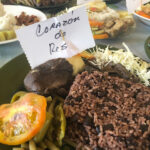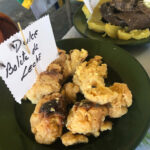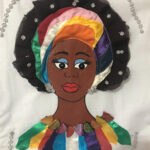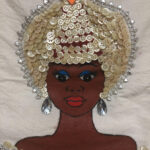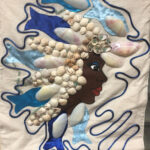The Small Activisms of Everyday Life (peer reviewed)
By Cindy García
Reconstructing La Casa Tomada mirArte
by Cindy García with Myrna Padrón Dickson
“Preparation of La Comida Tradicional in La Marina,” a scene reconstructed from bilingual notes
by Cindy García
The Artistic Practice of La Muñeca Negra
by Cindy García
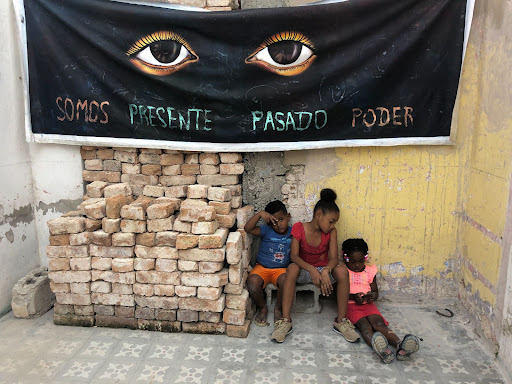
Keywords: Coco Solo, Marianao, La Marina, Matanzas, La Lisa, Cuba, La Casa Tomada mirArte, La Muñeca Negra, Anti-racist Activism, Translation, Decolonial Feminist Ethnography
Myrna Padrón Dickson of La Casa Tomada mirArte and I once had a conversation about what she called “the small activisms.” This includes activism of everyday life in the home and the neighborhood. Small activisms constantly seek openings to reconstruct possibilities for Black people and raise anti-racist consciousness. As Myrna says, small activisims can produce “big vibrations.” Myrna and her partner Siria González, for example, seek to normalize their relationship as cuir Black women who are also mothers. 1For more on the use of “cuir,” please see El lugar sin límites, Vol. 3 Núm. 5 (2021): Queer/Cuir de las Américas: traducción, decolonialidad y lo inconmensurable. Myrna offers space in her home for a band to practice and in return, they play music at La Fiesta de Doble Negras—a party at La Casa Tomada mirArte that brings together an LGBTQIA+ community. Myrna and Siria always seem to be scanning the neighborhood, finding ways to fill societal gaps and take care of those who need help. In 2020, a massive shortage of gasoline in Cuba caused the government to limit the public transportation on which so many people rely. This lack of transportation coincided with the pandemic. Myrna and Siria decided to facilitate rides to transport the elderly, children, and those most in need to hospitals for medical consultations.
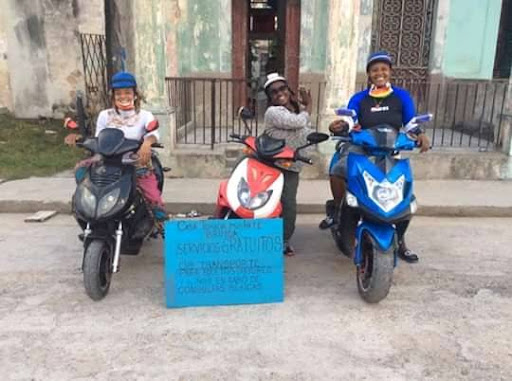
In these writings, I consider the small everyday activisms of the three projects featured in Activaciones: La Casa Tomada mirArte, La Marina, and La Muñeca Negra. In La Marina, a neighborhood in Mantanzas, Raúl “Kimbo” Dominguez, Yudania García, and the neighborhood coordination team prepare a traditional community meal by pulling together family recipes from their neighborhood. Margarita Montalvo and Maritza Arrango Montalvo work to dislodge the flattening histories, erasures, and exoticizations of black women by creating an alternative.
Each of these projects operates with little to no money, accessing what they need through recycling, repairing, or exchanging. The projects persevere in part because of networks of artists, activists, and others who exchange resources or skills. The networks are crucial—not just for finding resources and skills—a set of speakers, a strong singing voice, ripe mangos on a tree, a sewing machine—but also for sharing resources and skills—a washing machine, dance lessons, translation services, dry erase markers, drums, space. The exchange deepens social relationships and possibilities for collaborations.
One of my intentions is to make the writing process and relationships legible. My observations do not intend to impose totalizing narratives through writing-about, or objectifying the people with whom I am in relation. My intention is to find ways of writing-with them, pointing to our relationships, the fissures in my own knowledge, and the cultural and linguistic mistranslations. As such, the way I construct a narrative necessarily lends itself to being countered, critiqued, and retold from another perspective in the relationship, a perspective that may be found by the stories in Activaciones.
My relationships with the people and events in each space differ, and, consequently, so do the nuances of my Chicana feminist methodology. With Myrna and Siria, we socialized outside of project-based events. In Matanzas with Kimbo and Yudania, I was more of an observer of a cultural, culinary, artistic experience. At Margarita’s house, I learned very specific details of an artistic technique. My relationships with the people and activities in each space affected my perceptions, the details that made it into my notes, and the affective memories that may not have made it into my notes. The stories put into words attempt to present the subtleties of our interactions, and each narrative works with the subtleties through different structures: a collaborative ethnographic and digital storytelling, a visually annotated script, and a kineasthetic memory. All of these narratives I constructed with bilingual notes with varying degrees of detail and linguistic accuracy. The politics of translating these experiences and relationships to the page challenge every story of small activism that follows.
Reconstructing La Casa Tomada mirArte
Cindy García con Myrna Padrón Dickson
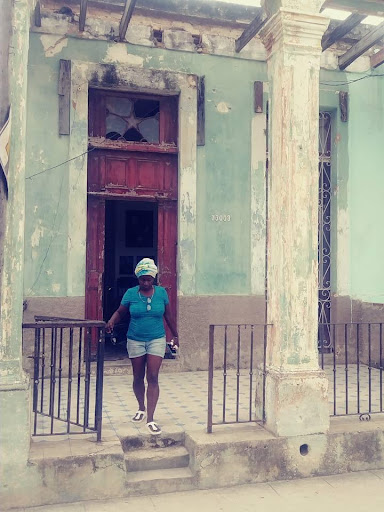
It was October of 2018 when Maxine and I were in Cuba at a symposium on anti-racism and Geoffroy Delaforcade introduced us to artist-activists Myrna Padrón Dickson and Sira González at the Casa Tomada mirArte. Myrna and Siria spoke to a roomful of visitors sitting around the front room, the first room that Myrna repaired in the house. They told us that they open their home almost 24 hours a day, welcoming the local neighbors of Coco Solo in Marianao, LGBTQ+ friends across Havana, and international visitors, such as Maxine and I, to have conversations about anti-racist, anti-homophobic activism and art. During the five months I did research in 2019, I observed Myrna as she took on the challenge of reconstructing a space that had fallen into disrepair. In the process, she has been transforming both the architecture and the energy to create a dynamic cuir space that nourishes their activist project as La Casa Tomada mirArte. Myrna, Siria, and the LGBT+ community that gathers at the house have covered the walls with art.
The house had once belonged to Myrna and her family, and had also been lost to them. Several years ago, Myrna reclaimed this house. Is that how Myrna’s story went?
As I write this in 2021, I cannot find the story of the house anywhere in my notes. How many times had I heard small details and large explanations of why this house is “tomada?” As an ethnographer, I almost always carried my notebook with me during the five months I lived there so that I could jot down notes. Yet, there were so many conversations that happened with Myrna and Siria on walks to the bus stop or in between the times I had identified as “work” times. Those, I think, are the conversations that affected me the most, the conversations that I didn’t write down because I was enjoying the friendship. My notes only partially help me to reconstruct details of the stories and relationships, and our ongoing friendship gives us the time to continue conversations over some of the ideas we considered important then and now.
March 17, 2021: I began a social media chat with Myrna that lasted about three days, to ask her again about the history of the La Casa Tomada. The conversation reflected the casual nature of punctuation and grammar that often characterizes communication in online messaging platforms. The conversation took place in Spanish and I translated it into English.
| Cindy: Se me olvidaron algunos detalles de la casa. Myrna. ¿Me puedes ayudar? Myrna, la casa era de tu familia y creciste allí? Si? ¿Y como perdiste la casa? ¿Como reclamo la casa? ¿Cuando me contaste esta historia, solo estaba escuchando como una amiga, así que no la escribí. Pero la historia es importante. Estoy escribiendo sobre cómo está reconstruyendo la casa y también reconstruyendo la familia y las ideas de igualdad LGBT. | Translation: I forgot some of the details of the house, Myrna. Can you help me? Myrna, the house belonged to your family and you grew up there, right? And how did you lose the house? How did you reclaim it? When you told me this story, I was listening as a friend and didn’t write it down. But the story is important. I am writing about how you are reconstrucing the house and also reconstructing the family and ideas about LGBT equality. |
| La Casa Tomada mirArte: Yo nací en otra casa. Literalmente en las escaleras del edificio. La casa actual fue otorgada a mi difunta madre por el gobierno municipal en categoría de compra venta. Es una construcción estilo colonial del 1902. El gobierno acordó que por subsidios repararla la vivienda ya que mis padres eran jubilados y adultos. Las condiciones de habitabilidad eran regulares – menores que ahora. Tenía todo el techo. Puertas y ventanas originales. Sin embargo no estaban óptimas ya que cuando la otorgaron llevaba muchos años cerrada. Las condiciones actuales surgen porque se empezó a reparar por esfuerzo propio de la familia no por el subsidio prometido por el gobierno.
Voy no he terminado la historia… |
Translation: I was born in another house. Literally on the stairs of the building. The current house was granted to my late mother by the municipal government in the category of purchase and sale. It is a colonial-style construction from 1902. The government agreed that for subsidies to repair the house since my parents were retired and adults. The habitability conditions were worse than now. It had the whole roof. Original doors and windows. However, they were not optimal since when they granted it it had been vacant for many years. The current improved conditions arise because the family began to make repairs, not because of the subsidy promised by the government.
I have not finished the story… |
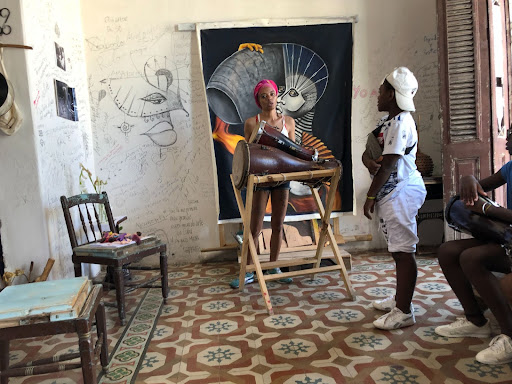

| La Casa Tomada mirArte: Parte del subsidio fue otorgado años después cuando ya la casa estaba mucho más deteriorada y mis padres muchos más viejos. El resto de la familia apoyamos siempre aunque estuvimos viviendo en otros hogares. La situaciones económicas a partir de los 90 hasta mediados del 2000 fue descabellada para todos. La familia apoyamos hasta donde pudimos, siempre con el sentido de que esa es La Casa, aunque viviéramos en otros hogares en matrimonio. Por ese entonces se enferma mi Papá largo tiempo hasta su muerte. Los ahorros económicos bajaron y por supuesto La Casa seguía sin reparaciones, el techo como era de madera comenzó a filtrarse con las lluvias, así también puertas y ventanas. | Translation: Part of the subsidy was awarded years later when the house was already much more deteriorated and my parents were much older. The rest of the family always supported us even though we were living in other homes. The economic situations from the 90s until the middle of 2000 were crazy for everyone. The family supported as much as we could, always with the sense that this is La Casa, even if we lived in other homes as a married couple. Then my Dad got sick for a long time until his death. The economic savings fell and of course the repairs on the house stopped, the roof as it was made of wood began to leak with the rains, as well as doors and windows. |
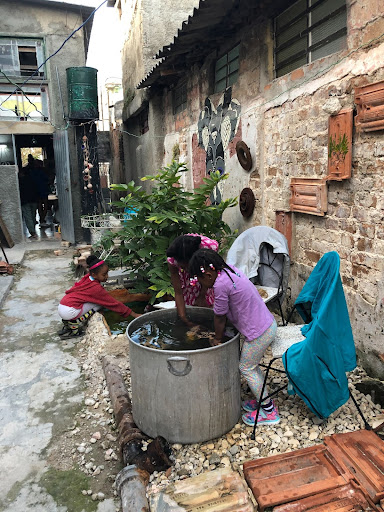
The roof was collapsing on the side of the house over the two bedrooms, but Myrna had cleared it away in order to use roofless rooms for open air neighborhood concerts and gatherings. Though there is no running water, Myrna and Siria continuously invite people into their home and often prepare food to share. Usually it’s little rolls with a tasty orange spread called pasta, but one time they cooked a caldo de pollo. Using an enormous pot lent by a neighbor, they set up a fire on the street in front of the house. They used some of the cinder blocks that had held up wooden planks for seating during gatherings. The seating seemed so essential, and I was surprised that they had destroyed the cinder blocks in the fire to make the soup.
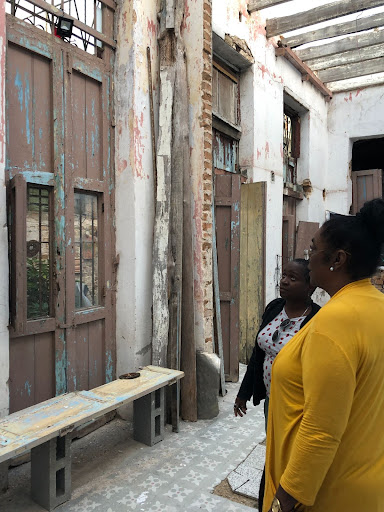
| La Casa Tomada mirArte: Primero muere mi papá y decidimos llevarnos Mima. Le preparamos condiciones en todas las casas de familia. Era La Reyna. Pero ella solo estaba conforme y tranquila pocos días. Montaba en cólera recogía sus cosas decía, “Me voy para mi Casa y partía sin escuchar a nadie. No le importaba si se estaba cayendo, esa es Mi Casa,” decía. Cuando vine a vivir con ella su vejez fue que sustituir el techo de los dos salones delanteros (madera por tejas de fibrocemento) Construí la meseta para cocinar. Y demolidos el techo de los cuartos, baño, y cocina original que es el sitio donde hacemos las actividades. Bueno aunque se toma toda la casa para la gozadera jajjajaja | Translation: My dad dies first and we decide to take Mima with us. We prepare conditions in all the family houses. She was La Reyna, the Queen. But she was only satisfied and calm for a few days. She would fly into a rage, gather her things, and say, “I’m going home and leaving without listening to anyone. She didn’t care if she was falling. That’s My House,” she said. When I came to live with her, her old age was to replace the roof of the two front rooms (wood for fiber cement tiles). I built the plateau for cooking. And demolished the ceiling of the rooms, bathroom, and original kitchen that is the place where we do the activities. Well, although he takes the whole house for the enjoyment hahahahaha |
That Spanish colonial house was taking a new shape, a house taken over, decolonized, and reconstructed as cuir. I specifically use the word cuir (not queer) to mark that colonization has affected the way that Myrna and Siria live their lives as they work against heteropatriachy’s colonial foothold.
A casa tomada. I talk with Maxine about this and she comments, “You can’t destroy the house, but certain bones need to be broken and reset.” I love Maxine’s metaphor. From so many conversations with Myrna and Siria, I know that their first and most basic everyday life activism is to simply exist as two women who are romantic partners raising children together. They wish to live in the house and walk through the neighborhood without being targets of violent words, gestures, or physical assaults. They do not disappear and attempt to hide from these violences. Rather, they actively perform that they belong to the neighborhood so that it becomes so. They reconstruct the house, they reconstruct their relationship with the neighborhood, they reconstruct family.
| La Casa Tomada mirArte: Continúo, Cindy. Cinco años antes de morir decidí venir a estar con ella. Cuidar de su Ezaimer. Me aterraba la idea de internarla en un Asilo de Ancianxs. Estaba a tiempo completo con ella, por esa fecha comenzó mi relación amorosa con Siria. No quería desligarme de mis compromisos como Art-vista entonces fue cuando surgió la idea de Casa Tomada por el Arte y la Cultura. Se fue sumando el ingenio de Siria, la buena vibra y Sapienza de artistas, activistas, vecino, estudiantes y profesores cubanos y estudiantes de EEUU partícipes en programas universitarios o socio-culturales. Todos de una manera u otra fuimos aportando el equilibrio energético que tiene hoy la Casa.
Hay muchas Casa Tomada en Cuba y otras partes del mundo la nuestra lleva el apellido mirArte.
Fin |
Translation: I continue, Cindy. Five years before she died I decided to come and be with her. Take care of your Ezaimer. The idea of placing her in a nursing home terrified me. I was full time with her, around that date my love affair with Syria began. I did not want to detach myself from my commitments as Art-vista, that was when the idea of Casa Tomada por el Arte y la Cultura came up. The ingenuity of Siria, the good vibes and wisdom of artists, activists, neighbors, Cuban students and professors and US students who participate in university or socio-cultural programs were added. All of us in one way or another contributed to the energy balance that the casa has today.
There are many Casa Tomada in Cuba and other parts of the world, ours bears the surname mirArte. The end
|
“Preparation of La Comida Tradicional in La Marina,” a scene reconstructed from bilingual notes.
By Cindy García

5/5/2019
I’m in La Marina, a neighborhood in Matanzas, for the 13th Havana Bienal, an exhibition of the arts that in 2019 also included Matanzas, Cienfuegos, Sancti Spiritus, and Camagüey. The official roster of artists and exhibits also inspired a number of grassroots community arts events. Raúl “Kimbo” Domínguez Valdez and Yudania García Alberja in La Marina spearhead a weekend celebration in their neighborhood Parque de la Aurora that includes an art exhibit by Emilio O’Farrill Almendariz, music and dance concerts by Los Muñequitos de Matanzas, Rumba Timba, and Los Reyes del Tambor. The highlight is the Comida Tradicional, the annual sharing of traditional foods made from family recipes passed down over the generations. The theme of the 2019 bienal is “The Construction of the Possible,” to highlight the ingenuity and creativity of Cuban artists.
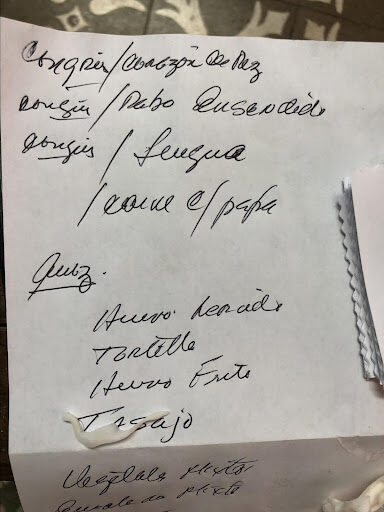
PEOPLE:
Kimbo and Yudania: Coordinators of Proyecto Identidad y Barrio in La Marina.
Vladimir Diaz Miranda: A chef of primer nivel, they tell me. I recognize him from the day before at the exhibition with the Muñeco de San Juan and the costumes that will be worn in the comparsa in June. He’s the sultán of Kimbo’s comparsa Sultán, and like a sultan, he improvises “choreografía libre” at the head of the comparsa to present the company. When I ask, they tell me there is only one sultán, and it’s Vladimir.
Aimara Padrón Aguillar: A friend who helps prepare the meal, Maria’s mother.
Maria Victoria Pedroso Padrón: A friend who helps prepare the meal, Aimara’s daughter.
Wilbur: A coordinator of the event.
Me: A U.S. researcher and friend of Kimbo and Yudania.
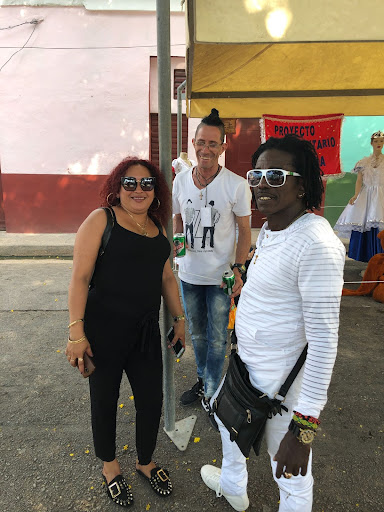
SETTING: Kimbo and Yudania’s house in La Marina.
NOTES: All of the original conversation happened in Spanish.
When I look back at the notes I wrote during this scene, I found that I wrote the dialogue and my thoughts in both English and Spanish. The language shifts in the dialogue demonstrate the way I transcribed the conversation in the moment rather than fully accurate citations of the original Spanish.
AT RISE: Yudania and Vladimir cook traditional foods from La Marina in Yudania and Kimbo’s kitchen.
YUDANIA:
This dish is called bolitas de leche.
(Yudania calls me over to see several bolitas frying in a pan and they smell delicious.)
It’s for kids que no les gustan los huevos o la leche. It is made with leche en polvo y huevo en agua con azúcar almíbar.

(Vladimir transfers the papas, the rabo de res, congrí and some of the other foods from pots and pans into small white plastic bags to be able to haul it to the event site a few blocks away. He has made a list of foods and begins to write the name of the food on a card he makes for each. Now he’s testing a dry piece of spaghetti to stick through the card to attach to each plate. Before anyone gets to eat the food at the festival, everyone gets to admire it in an exhibition.)
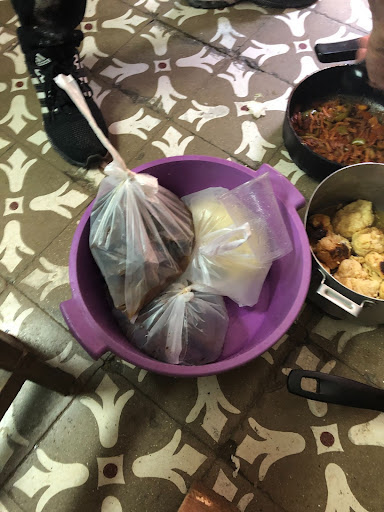
(Kimbo comes in with four long loaves of bread carefully stacked on his hand.)
KIMBO:
I can’t get a car or the chicharritas. It’s like the Periodo Especial. There’s no oil for chicharritas.
(Kimbo is also frustrated because he is unable to find someone with a car to deliver all the food to the event site.)
VLADIMIR:
It’s all that but no Periodo Especial.
KIMBO:
El pan siempre tiene que estar. Es tradicional.
VLADIMIR:
We make do with what we have.
KIMBO:
¿Sabes lo que falta? El ecó.
(To me.)
It’s like a tamal made with maíz and cáscara de plátano.
VLADIMIR:
(To Yudania)
Does bistec start with a “b” or a “v”?
(In his rush, he puts an x at the end instead of a c and decides to make a new card. I note the kind of care he takes to display the dishes as beautifully as possible.)
KIMBO:
Tenemos 19 serving plates but no smaller plates to serve the neighbors. Platícos.
(He goes to the next room and returns with a pack of 48 brown lunch bags.)
KIMBO:
Podemos usar estos. Just cut off the top and put food in it.
(To me.)
Someone brought these from the U.S.
(He tells me that, since his house is so small, the neighbors help him to store the things he needs for the big events: the tents, banners, drums, costumes, etc. He needs a bigger house, he says. I agree. He and Yudania are neighborhood leaders who organize a number of events all year. Kimbo is also a religious leader so he leads many spiritual events and meetings. A religious offering rests in each corner of the living room and chairs for about four people span two of the walls.
Maria and Aimara come in with carne con papas, papa hervida, chivo, boniato, y lengua de res. Maria and Aimara don’t live in La Marina, but they cooked in a neighbor’s house belonging to Mariela Alberja, on a block near Kimbo. They also carry a dish they shared with me: corazón de res. We all sample some of the food before it gets packed up.)
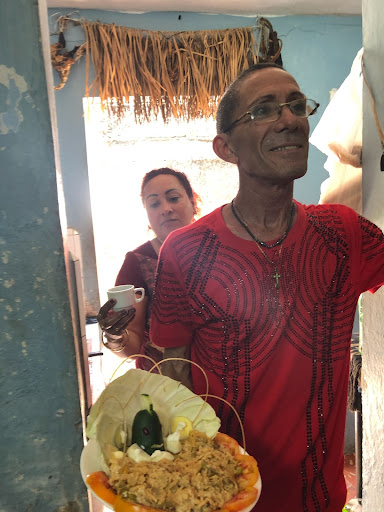
AIMARA:
Falta la jaiba.
MARIA:
¡Y la salsa que es riquisima! Vino seco, principalmente, ajo, cebolla, ahi. Invento comino, puree, pimienta blanca. Si no hay vino seco, le echo cerveza.
VLADIMIR:
(Jokingly.)
El próximo año, avestruz.
(Wilbur laughs.)
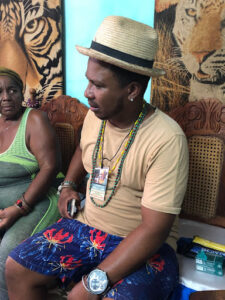
——–
An uncritical celebration of artistry can cover over a political context that strenuously extracts ingenuity from people trying to create humane conditions for themselves. The U.S. sanctions have disallowed trade and stalled the Cuban economy, harming people of Cuba in the practice of everyday life. As noted in this edition’s articles written by Maritza López McBean, Rolando Zuleta, Idelsi Alfonso Sandrino, and Damayanti Matos Abreu, the racial inequities since colonization and that continued after the Revolution have disproportionately affected the way that Black Cubans experience U.S. sanctions. During my time in La Marina and La Lisa, both primarily Black neighborhoods, I observed a number of shortages of goods like cooking oil, chicken, eggs, flour, and soap. To my surprise, fish and coffee were luxury items that international travelers enjoyed, but were not readily accessible to the Black Cubans. Yes, these shortages affected Cubans across color lines, but especially Black Cubans. And still, I am told, none of this was as bad as the conditions during the Periodo Especial, a temporal marker for the worst of economic times. Like many Cubans, the community leaders in La Marina are aware of how the U.S. blockade affects their daily lives and calendar of annual neighborhood events, such as the Comida Tradicional.
The Comida Tradicional did not happen in 2020 or 2021, due to the COVID-19 pandemic. It recently happened in January of 2022. The visually-annotated scene above is from the Comida Tradicional in 2019. In preparation for this event, the neighbors share their traditional family recipes that make up La Marina’s cuisine, otherwise “we start to forget,” Kimbo tells me. He demonstrates an urgency around keeping these practices alive because he has observed the slow death of other practices and how it changes his community. Once I accompanied him to a planning meeting for this event. During the meeting, he emphasized “the methods of La Marina” – a way of recreating the festival that highlighted the knowledges, artistry, and skills of the neighborhood rather than bring these things in from elsewhere. Given this framing, the artistic exhibition of the food pronounces the sophistication of the Black people of La Marina–they are brilliant historians, artists, and chefs. He tries to involve everyone in La Marina who would like to be part of the festival, giving everyone a job that he knows they can accomplish. He also includes others like Vladimir, Maria, Aimara, and even me to assist in the backstage aspects of the production.


As I sit in this Matanzas living room, I am moved by each culinary detail that someone shares with me and with each other, especially Yudania’s demonstration of how to make bolitas de leche and Maria’s innovative salsa recipe. Platícos, la jaiba, and enough oil are not possible, but the coordination team collectively remembers what is missing this year, or maybe hasn’t been available for many years. These are leaders in the neighborhood whose backstage ingenuity, creativity, frustrations, and nostalgias might not be apparent to the neighbors who view the artistically-staged meal. The menu does not remain stable year to year and relies on their memories of recipes as much as it does the availability of the ingredients. As the coordination team constructs what is possible, what has become more of a challenge this year, they reconstruct their memories and the cultural practices of the Black Cubans of La Marina. This small act of activism demonstrates to residents of La Marina that their culture is dynamic, shifting with the political-economic currents and bound in community. They make do, as Vladimir says, to produce a neighborhood history of culinary abundance.
The Artistic Practice of La Muñeca Negra
By Cindy García
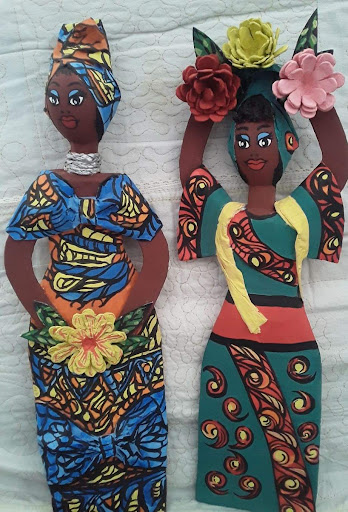
Maritza López McBean often collaborates with the Centro de Martin Luther King (CMLK). She introduced me to sculptor Margarita Montalvo of La Lisa and her niece Maritza Arango at the CMLK when they were giving a presentation to visitors from a U.S. university. El Proyecto La Muñeca Negra occasionally accompanies the Red Barrial Afrodescendiente in presentations. Margarita is the director and her niece Maritza Arango (whom I will now refer to as “Maritza A.” so as not to be confused with Maritza López McBean) is the coordinator. Accompanying them was Miriam Miranda Miranda, who was part of a cooperative of women that Margarita had trained in the techniques of papel maché through the project.

Margarita had been a professor of Artes Plásticas and had worked for several years at the Casa Comunitaria Paulo Freire in Balcón Arimao, La Lisa. She worked with children, youth, and older adults, teaching them techniques of papel maché. When she retired, she brought the project with her to her home in Las Alturas de La Lisa, just around the corner from Iglesia Santa Ana. On weekdays, the women of the cooperative come to create with papel maché as Margarita mentors them as artists and businesswomen. They earn money from the things they make and sell. They say it isn’t that much money, but that over time it adds up. One woman was able to fix her kitchen and another her bathroom from making and selling the muñecas. The project creates economic opportunities for women, who have often been overlooked by the economic opportunities afforded Black people as a result of the revolution.
I joined Margarita, Martiza A., and Miriam in laying out their artistic creations on table tops and hanging tapestries from little nails we found already in the walls. Adding to the papel maché collection, Maritza A. was the artist who made the tapestries that depicted the Orishas in feminine form, for example, in the pictures of Oyá, Obatalá, and Yemayá.
Using recycled materials and papel maché, Maritza A., Margarita, and the women in the cooperative had made the urns for the Orishas, bells, puppets, and muñecas negras. “This is made from an egg,” Margarita told me, pointing to the head of one of the muñecas.
When the visitors from the university entered the room, the three women of the cooperative presented their project, speaking of the importance of creating Black dolls that were not racist, eroticized stereotypes of Black Cuban women. The stereotypes often stand in for conceptualizations of the nation, overtaking other conceptualizations of Black women, and dampening social and economic possibilities for Black Cuban women. In challenge to this dominant history, the women of El Proyecto La Muñeca Negra are always inventing ways to artistically re-imagine Black Cuban women as powerful and beautiful, shaping them into being as they knead their fingers into an emerging body.

Someone at the presentation asked them what happens after the art is made. “We commercialize it. We sell it at places like the Feria de Libros.” They also make toys to donate to daycares. At the core of their artistic project was a commitment to the neighborhood community at the intersection of race, gender, environmental consciousness, and the spirituality of Black Cubans. Though they said these kinds of things at their presentation, I began to understand the implications of this work more deeply in practice at Margarita’s home.
On a Tuesday morning not long after the presentation, I walked over to visit Margarita at her home just a few blocks away from where I was living in Balcón Arimao. Milagros (Mily), a friend of Maritza A.’s, was starting her first day working with the muñeca project. Margarita was teaching Mily to make a bell, and I was to learn that ringing a bell was the way to call Ochún to begin a prayer. The bell was a spiritual object from Santería as were so many of the papel maché pieces the women of the cooperative created. As a child of Ochún and an Iyalocha, Margarita is the beloved godmother to many people in the community, having initiated them into Santería. Her house is not just a home and a workshop, it is also a Casa Templo, a sacred space that her godchildren stop by now and then to pray at the altar along the wall of the living room.
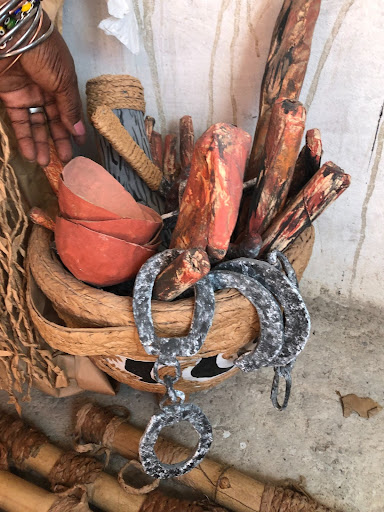
Sometimes the women work on the patio in front of the house and sometimes they work just inside the door in the living room. This is where I was sitting and chit-chatting with Margarita and Mily. On the floor next to the TV are two different wood sculptures that Margarita had carved years before, visible to Mily who was working on the couch across the room. “Tía,” said Mily to Margarita, “¿Hiciste esas sculpturas también?” Margarita, who has won many awards for her sculptures, confirmed that she had made the sculptures. She said that she had so many sculptures and pieces of art, too many to fit in her house. She asked friends to keep them in their homes and they did, putting them on display.
Mily was often at Margarita’s on the days that I went. She told me that going to Margarita’s home was more than just learning how to create art. It was healing for her and for other women as they bonded as they worked. Mily’s mother had recently passed. Martiza, aware of her friend’s deep sadness, invited her to join the project. Mily explained to me that as the women worked, they sang popular songs, talked about their problems, and told stories about their families. It was like going to therapy, she joked, though we both knew she was serious.
It was Mily who became my mentor after she had been trained intensively by Margarita over a couple of months. “Cindy, estás lista hacer una muñeca negra?” Margarita asked me one day. She instructed Mily how to begin teaching me. We worked side by side on the couch, while smoothing papel maché glue mixed from flour, water, and vinegar, over muñeca arms that we cut from thin cardboard. “You have to make sure there aren’t any lumps. It should all be flat and the edges smooth.” This was harder than it had first appeared because the arms were curved and I had to cut the edges of the paper to overlap the perimeter without wrinkles. Mily would glance from her muñeca arm to mine to examine how successful I was. “¿Ves esta parte aquí? Necesitas más pegamento.” Yes, I definitely needed more glue.
Note: As I write this, I realize that some of my notes are in Spanish and some are in English, but all of the conversation was in Spanish. Rather than insert the Spanish translation in here, followed by an English translation, I am choosing to transcribe the conversation as I did in the notes I took after I left that day. Though my Spanish was good, I was never going to remember the Cuban word for “lumps.” My translation into English then, relied on my ability to put the practice into words I could remember, focusing on the techniques and the way that Margarita and Mily critiqued me in Spanish.
“If you don’t level this part out, the paint won’t go on evenly.” And just when I thought I had skillfully completed the bent section of elbow, a flap popped up. “Más pegamento,” said Mily. Margarita looked over from across the room. “Tell her to massage it, Mily. Make sure she develops that technique,” she said, mentoring Mily who was mentoring me. After about forty-five minutes of armwork, Margarita came to inspect. She critiqued both Mily’s work and mine. “If corners form,” she said, “you have to massage the paper to make it more pliable.” She turned to me, “You have a good eye for detail, but you need to work on these spots before you go on to the head.” Then, with a more stern voice, she said something like this, “We have to learn good technique. People expect our work to be unrefined, because we use recycled materials. It is our technique that changes it from garbage to art.”
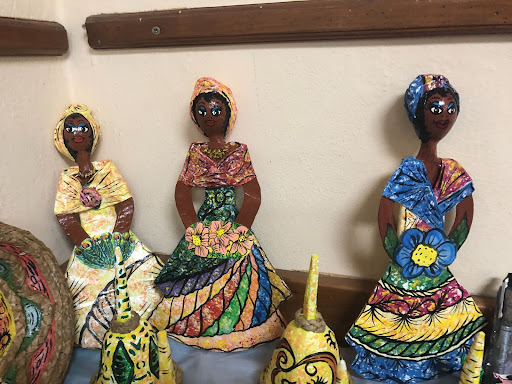
As I massaged more glue into the ridges and corners, I reflected on Margarita’s demand for quality. Technique, refinement, discipline. The Black and Mestiza women of La Muñeca Negra create art. I state the obvious that that has long been denied to Black bodies: they are intelligent, thinking bodies who pass on the skills and knowledge through intensive training with rigorous standards. I am reminded of Anthea Kraut’s “Black Authenticity, White Artistry” 2A chapter from her book, Choreographing the Folk: The Dance Stagings of Zora Neale Hurston. Minneapolis: University of Minnesota Press, 2008. where she traces the ways that Black dance and dancers were considered the untouched, unskilled, raw materials for White choreographers to turn into art. Journalists, event programs, and cartoonists did not recognize the intelligence and training involved in Black dance. Kraut draws attention to that process of erasure and attunes readers to the training and techniques of Black dancing bodies. Margarita seems to ground her training with an understanding of the racist dynamic that refuses Black artistry. As she pushes the women in the workshop to develop a more meticulous practice, she dislodges racist perceptions of Blackness by dazzling with Black creativity.
The arm I’d been smoothing finally passed Mily and Margarita’s inspection. Mily told me to put it on the patio to dry in the sun and pick up an egg, hollowed and dried out on the inside. I set the wet arm down in a row of other drying arms and found a small bag of eggs. I moved on to smoothing smaller pieces of paper onto the shell, carefully pressing down the ridges and bumps without breaking it. Mily continued to discipline me in the making of my first muñeca negra.
I was to learn that no single doll was created by a single artist and that the construction was more of a collective process. When I laid the egghead out to dry, Mily told me to grab a head that had already dried to attach to an already-dried body. The head I made would be picked up by someone else when dry. In this way, Mily trained me to assemble a muñeca, part by part, and it took several days. At the end of this first session, as Mily and I prepared to leave, Margarita took out her notebook to mark who completed what. She added me to the roster to track my progress and credited Mily for work that she would soon pay her for.
I left Cuba moved by the collective care and ingenuity of La Muñeca Negra. While Margarita may have been the one to attend school in Artes Plásticas, she has shared her knowledge by mentoring women into the collective. Yet, members of the collective are not the only ones who learn Margarita’s artful techniques and contribute to the making of the dolls. She has taught the neighbors to drain egg yolks through tiny holes and to search for materials they think could be used to make dolls. They save plastic bottles, buttons, scraps of material, and even deodorant roll-on balls that the cooperative uses to form the noses of puppets. Margarita also teaches neighborhood students to make little mice and puppets on Saturday mornings.
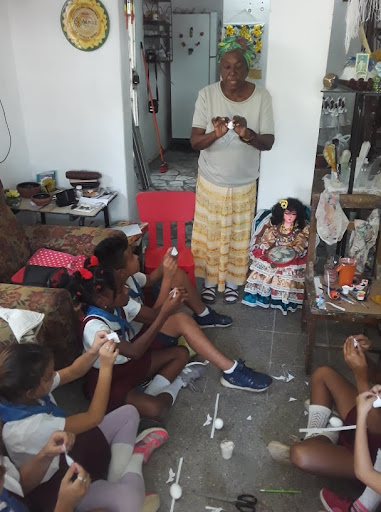

By turning to the details of the practices–the techniques, the codes, the contexts–I am able to get a better sense of how the cooperative navigates patriarchy and racism to artistically reconstruct concepualizations of Black Cuban women. Together, they care for their neighborhoods, they care for the environment, they care for each other in these small activisms. Their collective practices bring into relief the contours of a decolonial imaginary in which Black Cuban women differently inhabit the neighborhood, the nation, and the world.
Small activism, as Myrna says, is not a massive protest in the streets. Small activism happens everyday, activating opportunities to strengthen relationships, uplift a community, and make legible the joy and creativity of Blackness. Perhaps this kind of activism has not yet provoked a revolution, but it can radiate beyond the neighborhood.
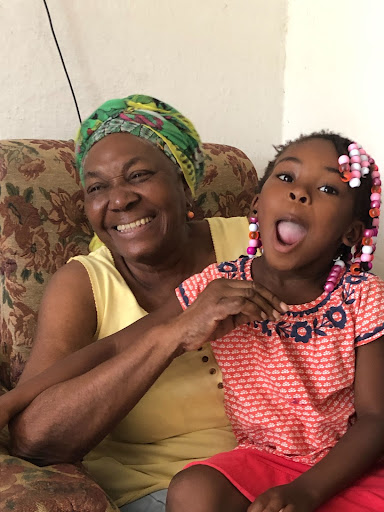
In Minnesota 2022, my daughter’s second grade class is getting ready to study “community,” and we are preparing to share how she and I became part of the Muñeca Negra community. The puppet and the Yemaya muñeca that Margarita gifted us will help to tell the story of their artistry and their small activism.
- 1For more on the use of “cuir,” please see El lugar sin límites, Vol. 3 Núm. 5 (2021): Queer/Cuir de las Américas: traducción, decolonialidad y lo inconmensurable.
- 2A chapter from her book, Choreographing the Folk: The Dance Stagings of Zora Neale Hurston. Minneapolis: University of Minnesota Press, 2008.

